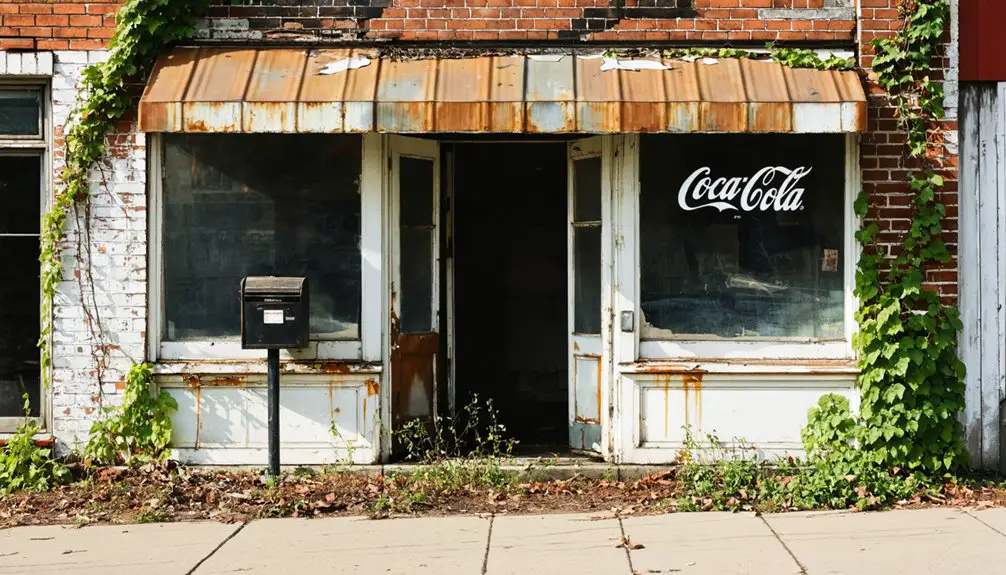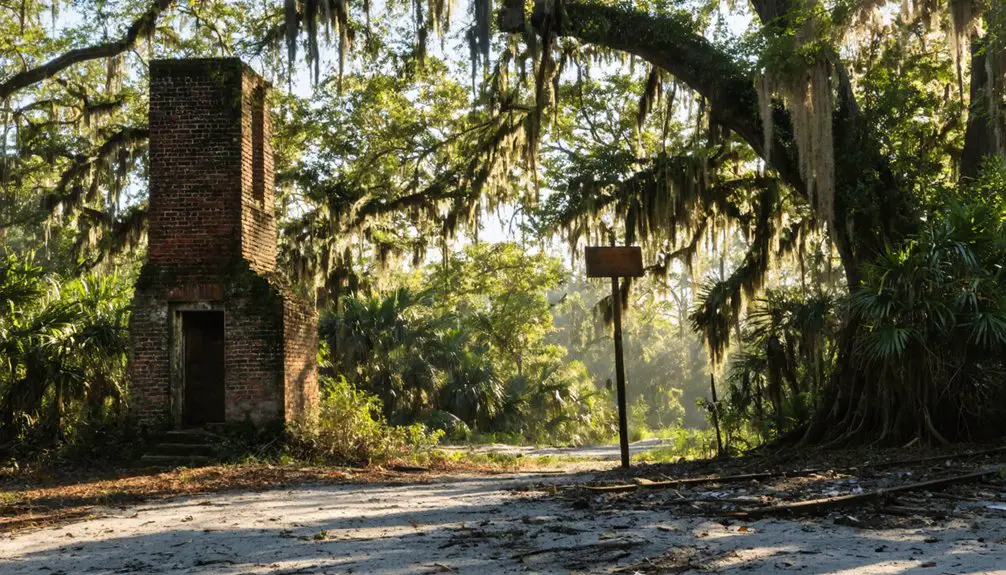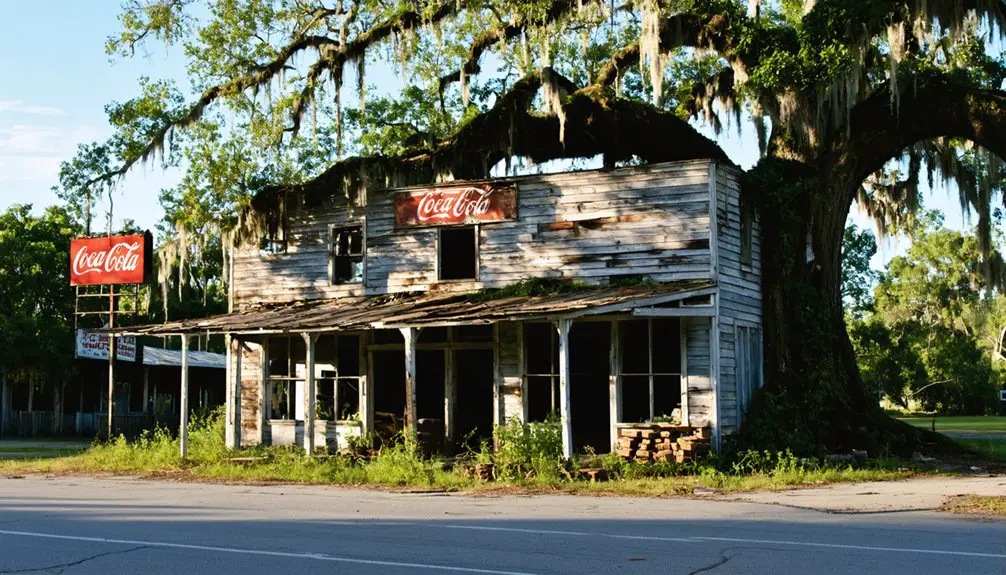You’ll find Hague, Florida as a rare inhabited ghost town where historic homes and structures from its 1880s railroad heyday still stand. The town flourished after the Florida Southern Railway made it an essential transportation hub, with lumber mills, agricultural operations, and a bustling commercial center. While the railroad’s decline, boll weevil crisis, and Great Depression led to its downturn, dedicated residents maintain pieces of its rich past, including the restored 1880 Old School House-Methodist Church.
Key Takeaways
- Hague is an inhabited ghost town in Florida that emerged as a railroad hub in the 1880s before declining after rail service ended.
- The town retains historic structures including late 19th-century homes and the restored 1880 Old School House-Methodist Church.
- Economic decline occurred due to railroad collapse, boll weevil infestation, timber depletion, and the shift toward corporate farming.
- Original settlers’ descendants maintain some historic railroad homes, though preservation efforts face challenges from Florida’s climate.
- The town’s cemetery features distinctive tombstones of early settlers and Civil War veterans, preserving local historical significance.
The Rise of a 19th Century Railroad Hub
Railroads transformed Hague from a remote inland settlement into a bustling transportation hub in the 1880s. When the Florida Southern Railway extended its line from Gainesville in 1883, you’d have witnessed the community’s significance grow almost overnight. The railroad’s arrival marked a turning point, helping overcome the challenging Florida terrain that had long isolated inland settlements.
The community transformation was remarkable as Hague became a northern terminus, connecting to a network that stretched from Gainesville south to Ocala and Leesburg. A key Palatka Branch line connected the main route to coastal trade through Hawthorne and Interlachen. By 1902, the railway system became part of the larger Atlantic Coast Line through a significant merger.
You would’ve seen new businesses spring up around the tracks, while the railway enabled local farmers to ship their crops to distant markets. This essential transportation link integrated Hague into a broader system that included major ports like Cedar Key and Fernandina Beach, cementing its place in Florida’s growing economy.
Early Industrial Infrastructure and Development
While the railroad brought connectivity to Hague, it was the town’s early industrial base that transformed it into a thriving commercial center by 1888.
You’d have found a bustling hub of industrial commerce, with two lumber mills processing timber and numerous agricultural operations shipping produce north. The establishment of the post office in 1883 and an express office by 1888 facilitated robust community growth and trade networks. Unlike its Dutch namesake which serves as the seat of government for the Netherlands, this Florida town remained primarily focused on commerce and industry. Similar to the later Copeland Sausage Company that became a major employer in nearby Alachua, Hague’s industries provided significant economic opportunities for local residents.
- Two active lumber mills supplied construction materials and railroad infrastructure
- Large-scale fruit and vegetable shipping operations to northern states
- Strategic location on the Savannah, Florida and Western Railway
- Multiple stores and three churches supporting commercial activity
- Post office and express office enabling essential communication and trade logistics
Historic Structures and Architectural Legacy
Despite the passage of time, several historic structures from Hague’s prosperous era remain standing today, offering glimpses into the town’s architectural heritage.
You’ll find late 19th-century homes built by settlers like James and Esther, showcasing classic Old Florida architecture with hardwood construction and original craftsmanship.
While preservation challenges have led to the loss of many railroad-era buildings, some historic homes are privately maintained by descendants who’ve protected these treasures through careful upkeep, similar to how Kerr City structures survive along the old stagecoach road.
The town’s cemeteries stand as crucial architectural remnants, featuring distinctive tombstones that mark the final resting places of early settlers and Civil War veterans.
Union soldiers’ graves display curved tops, while Confederate markers bear pointed designs, silently telling the story of Hague’s divided past.
The Amanda homestead ruins in the surrounding woods reveal sophisticated construction techniques with evidence of two-story architecture and detailed shelving work.
The Old School House-Methodist Church Story
You’ll find the Old School House-Methodist Church, built in 1880, stands as one of Hague’s most significant historic structures after undergoing careful restoration in 1982.
The building served dual purposes as both a schoolhouse and Methodist church, reflecting the resourceful spirit of rural Florida communities in the late 19th century. Similar to early Methodist Circuit Riders, preachers would travel to serve multiple communities in the region. Just as the First Methodist Church did in Alachua, this building played a vital role in supporting the spiritual needs of the community.
While the school closed its doors in 1952, the structure’s importance to local heritage prompted preservation efforts that help maintain its historical integrity to this day.
Historic Preservation Efforts
Since its construction in 1880, the Old School House-Methodist Church has stood as a monument to Hague’s cultural heritage, surviving through dedicated preservation efforts.
You’ll find that community engagement played a vital role in its 1982 restoration, which aimed to maintain the building’s architectural integrity while facing significant preservation challenges. Past lessons from sites like Island Grove Methodist Church, which faced severe structural deterioration, inform current preservation strategies for this historic building.
- Local preservationists continue battling harsh Florida weather and structural aging
- The building’s dual purpose as church and school required careful consideration during restoration
- Unlike the lost Island Grove Methodist Church, this structure remains standing due to ongoing maintenance
- Roof repairs and stability work help protect against environmental threats
- The building serves as a rare preserved landmark in what’s now largely a ghost town, marking the community’s educational and religious legacy
Community Worship Continues
When Methodist circuit riders first arrived in Florida during the 1820s, they established a pattern of worship that would shape Hague’s religious landscape for generations.
You’ll find that early Methodist services took place in homes and the old school house, which served as a crucial community center before a dedicated church was built in the 1880s. Much like Gainesville’s first Methodist congregation which also met in shared church spaces, the Hague community initially gathered wherever they could find room to worship.
Even as Hague’s population declined, religious continuity remained strong. The Methodist church played a central role in maintaining community identity, hosting regular services, social gatherings, and special events.
Whether meeting in the church building or returning to the old school house site, residents and former community members kept their faith alive through seasonal services and reunions, demonstrating how deeply Methodism had become woven into Hague’s social fabric.
Economic Decline and Population Shift

You’d find Hague’s economic importance severely impacted when the railroad industry collapsed and critical facilities like the depot closed, leading to the removal of tracks that had once been the town’s lifeline.
The devastating boll weevil infestation crippled cotton production, while timber resources dwindled, causing local mills to shut down and employment opportunities to vanish.
As jobs disappeared in the post-war period, families moved away in search of better prospects, leaving behind empty homes and shuttered businesses that transformed this once-bustling railroad town into a ghost town.
Railroad Industry Collapse
During Florida’s Civil War era, the ambitious Florida Railroad linking Fernandina to Cedar Key met devastating setbacks that would foreshadow the industry’s eventual collapse.
You’ll find that railroad expansion faced constant challenges, from Union shelling destroying essential infrastructure to widespread financial insolvency plaguing major rail companies.
- The 1920s land boom briefly energized rail growth until devastating hurricanes struck.
- Edward Ball’s takeover of FEC during 1960s bankruptcy highlighted decades of struggle.
- Cuba’s expanded embargo in 1962 crippled essential trade routes.
- Labor disputes and bondholder litigation drained resources.
- Bank failures starting in 1926 cut off critical funding for maintenance.
Agricultural Production Downturn
As the twentieth century dawned in Hague, agricultural prosperity began unraveling through a series of devastating setbacks.
You’d have seen the agricultural decline unfold as the boll weevil devastated cotton crops between 1910-1925, forcing many of your neighbors to abandon their farms. The region’s crop vulnerability became painfully clear when attempted alternatives like satsuma citrus failed due to climate uncertainties, while the tung oil industry’s eventual collapse further limited your options.
The Great Depression delivered another brutal blow in the 1930s, leaving many of you heavily mortgaged and struggling with rock-bottom commodity prices.
With mounting economic pressures and the shift toward corporate farming, you watched as family farms gradually disappeared, transforming Hague’s once-thriving agricultural community into a shadow of its former self.
Post-War Population Exodus
While World War II initially brought modest prosperity to Hague, the post-war period marked a turning point in the town’s population decline.
Like many rural North Florida communities, Hague faced significant population migration as economic factors drove residents toward urban centers. You’ll find that the town’s exodus followed the broader pattern of Florida’s rural interior, where declining agricultural opportunities and lack of economic diversification led to sustained outward movement.
- Loss of traditional farming jobs accelerated the departure of working-age residents
- Small population base made Hague especially vulnerable to economic downturns
- Limited employment alternatives prevented the town from retaining younger generations
- Housing market collapse in later decades further discouraged new residents
- Unlike university towns or retirement communities, Hague lacked economic stabilizers to maintain its population
Transportation Evolution and Rail Removal

Once the Florida Southern Railway established service through Hague in the 1880s, the town’s transformation into a bustling agricultural hub began in earnest.
The arrival of the Florida Southern Railway in Hague sparked rapid growth, turning a quiet settlement into a thriving center of agriculture.
You’d have witnessed about 24 trains daily passing through, hauling citrus, timber, and cotton to distant markets. The railroad’s infrastructure included a station, water tank, and support buildings that became the town’s lifeline.
But when devastating freezes hit in 1894-95, they crippled local agriculture and began a chain reaction. As crops failed and populations dwindled, freight evolution saw transportation alternatives like trucks and highways gradually replace rail service.
While specific abandonment dates aren’t recorded, the rail line’s removal marked Hague’s shift to a ghost town, leaving only the old station site and water tank as silent witnesses to its railroad heritage.
Impact of Agricultural and Timber Changes
If you’d lived in Hague during the late 19th century, you’d have witnessed the devastating impact of agricultural pests and freezes that destroyed local cotton and citrus crops.
The town’s early prosperity from cotton farming declined as soil exhaustion and boll weevils forced many farmers to abandon their fields or sell to larger agricultural corporations.
Agricultural Pests Hit Hard
As Florida’s agricultural landscape transformed in the 1970s, devastating pest outbreaks severely impacted crop production around Hague and throughout the state. You’d have seen the harsh reality of pest management challenges, particularly when leafminers wreaked havoc on local farms.
The region’s crop resilience was tested as traditional pesticide use led to resistance problems and disrupted natural pest control.
- IPM practices became your best defense, requiring careful monitoring every two weeks
- You’d to adapt as tobacco declined and new pest pressures emerged with different crops
- Natural enemy conservation became critical to your farm’s success
- Biological control methods helped reduce your reliance on chemicals
- Research stations, like the North Florida Center, gave you tools to fight back against emerging threats
Timber Resources Run Dry
The timber industry’s rapid growth in late 1800s Hague brought more than just economic prosperity – it brought an unsustainable pace of resource depletion.
You’d have witnessed massive logging operations clearing old-growth cypress and pine forests, while turpentine extraction severely damaged surviving trees.
Present-Day Remnants and Preservation

Present-day Hague stands as an inhabited ghost town with limited physical remnants of its historical past. You’ll find no extensive ruins or dedicated historical markers to guide your exploration, as nature and modern development have largely reclaimed the original townsite.
While local gravesites and possible old cemeteries persist, preservation efforts remain minimal, challenged by Florida’s aggressive climate and vegetation.
- Access remains straightforward through Alachua County roads, though you’ll need to hunt for subtle traces
- Road names and small landmarks might still carry the “Hague” designation
- Local historical societies, rather than state agencies, maintain what little preservation exists
- Natural overgrowth and modern buildings have blended with any remaining historical features
- Unlike other Florida ghost towns, Hague lacks formal tourist infrastructure or interpretive signage
Geographic Location and Climate Features
Located in north-central Florida’s Alachua County, Hague sits at coordinates 29°46.2’N latitude and 82°25.3’W longitude, just off Highway 441 between Gainesville and Alachua city.
The town’s geographic significance stems from its position along a historic shipping railroad that once drove regional commerce.
You’ll find the terrain is mainly flat to gently rolling, featuring mixed pine and hardwood forests that once supported a thriving timber industry.
The climate impact is typical of humid subtropical regions, with mild winters and warm summers that influenced local agriculture.
The area’s sandy loam soil proved ideal for cotton farming until boll weevil infestations struck.
While rainfall distributes throughout the year, summer brings increased precipitation from Florida’s characteristic thunderstorms, making spring and summer the best times to explore the ghost town’s remains.
Photographic Documentation and Heritage Protection
While documenting Hague’s historical structures poses unique challenges, photographers and preservationists must navigate private property restrictions and deteriorating conditions to capture the town’s remaining heritage.
When practicing photographic ethics, you’ll need to respect landowners’ privacy while racing against time to document vanishing structures. The 1880 School House-Methodist Church, restored in 1982, stands as a symbol of successful preservation efforts.
- Original architectural features like tongue and groove flooring make compelling subjects for documentation techniques.
- Local families maintain some historic railroad homes through basic repairs.
- Cemetery sites and homestead ruins offer additional documentation opportunities.
- Limited institutional support means most preservation relies on community efforts.
- The town’s railroad legacy, including the water tank and station site, requires sensitive documentation to tell Hague’s economic story.
Frequently Asked Questions
Are There Any Haunted Locations or Ghost Stories Associated With Hague?
You won’t find documented haunted legends or ghost sightings in Hague. While the town’s historic buildings, including the 1880 Old School House-Methodist Church, remain standing, no paranormal activity has been reported.
What Is the Current Population of Hague as of the Latest Count?
While a million census takers might wish they knew, you won’t find recent census data for Hague’s population. As a ghost town, it’s effectively uninhabited according to current demographics.
Can Visitors Access the Remaining Historic Buildings for Guided Tours?
You won’t find guided tours of Hague’s historic buildings, as they’re privately owned and not preserved for public access. You’ll need to explore nearby towns offering structured historic preservation tours instead.
Which Original Family Names Are Still Connected to Properties in Hague?
Picture old mailboxes weathered by time – you’ll find the Jolly and Bradley family legacies still tied to Hague properties today, with their historic homes and farmlands marking enduring local property connections.
Does Hague Have Any Annual Events or Celebrations Honoring Its History?
You won’t find any annual celebrations honoring Hague’s history today. While nearby towns host various cultural events, Hague itself doesn’t maintain regular commemorative gatherings or historical festivals for its community heritage.
References
- https://www.ghosttowns.com/states/fl/hague.html
- https://www.youtube.com/watch?v=rMRJqCEJxbA
- https://www.cityofalachua.com/discover/about-alachua/history/a-prelude-to-a-town
- https://www.thetravel.com/skip-bodie-for-abandoned-ghost-towns-in-florida/
- https://theforgottensouth.com/jolly-house-alachua-florida/
- https://en.wikipedia.org/wiki/Florida_Southern_Railway
- https://www.hmdb.org/m.asp?m=55038
- https://theclio.com/entry/21025
- https://fdotwww.blob.core.windows.net/sitefinity/docs/default-source/environment/pubs/cultural-resources/floridas-historic-railroad-resources-mps_nrhplisted04052001_ms6289.pdf?sfvrsn=42f8a61f_2
- https://digitalcommons.unf.edu/historical_architecture_main/7417/



